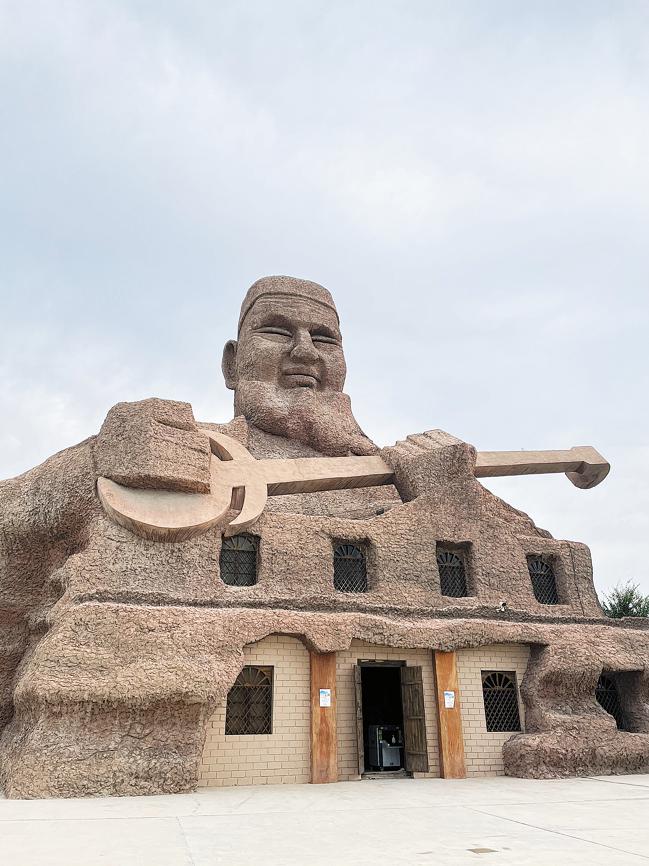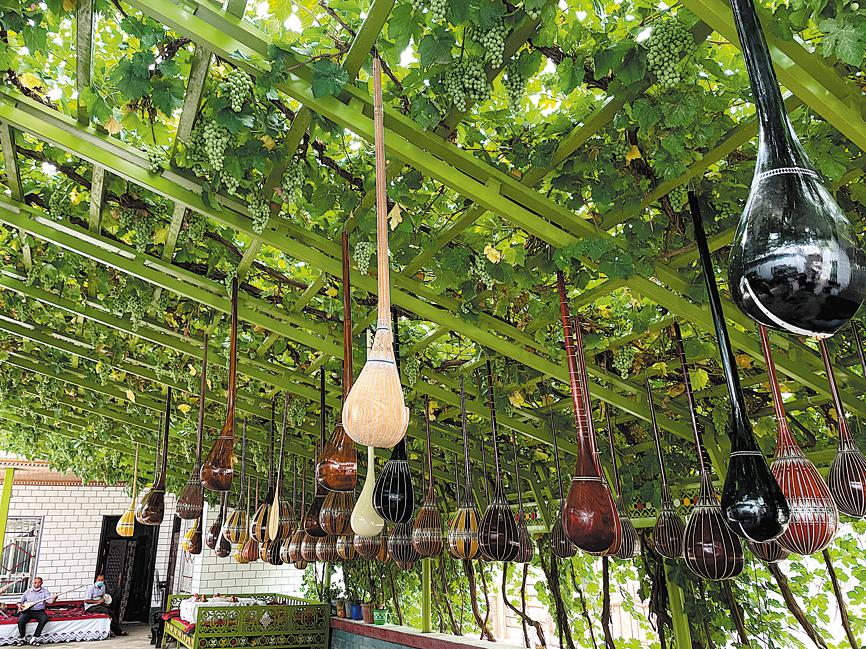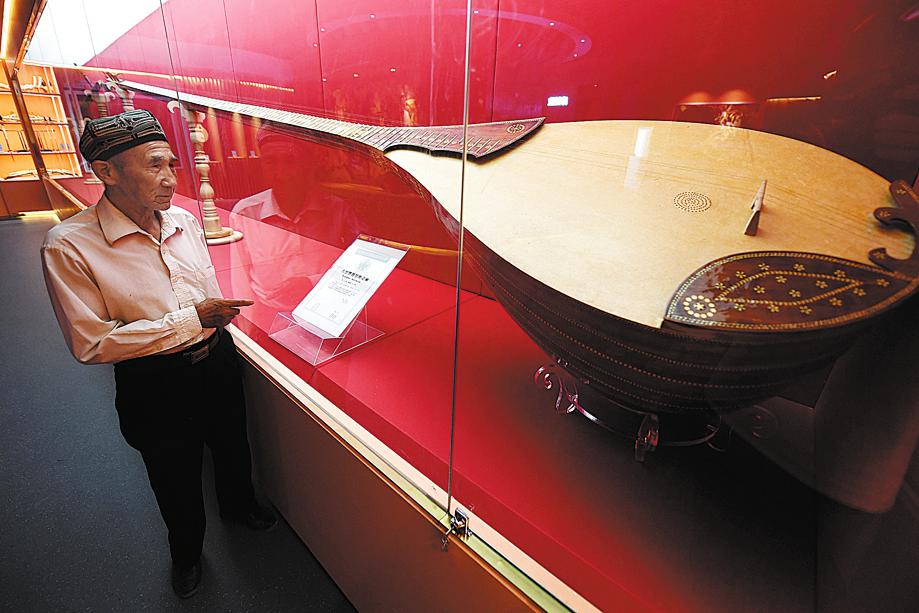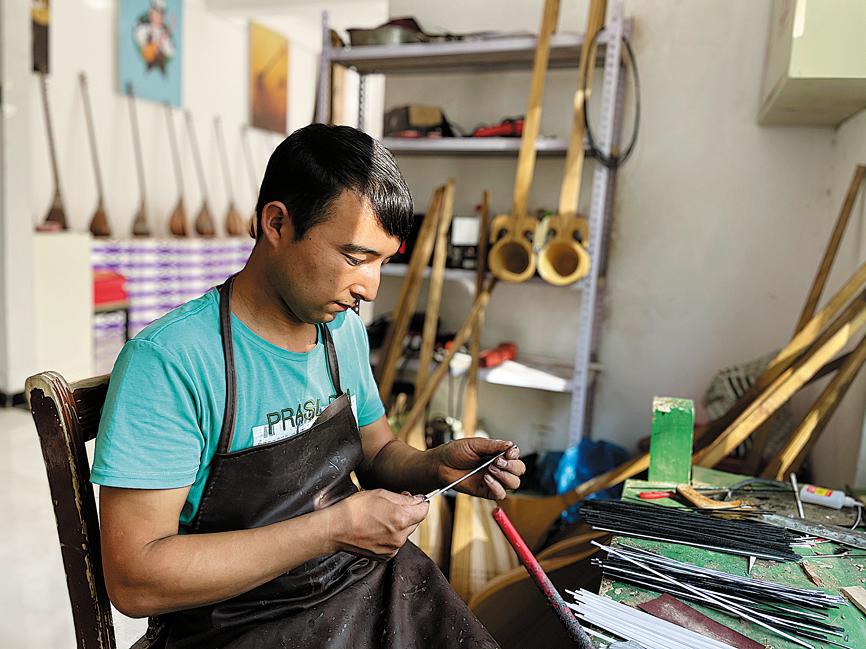
A display of some of Anwar Axim 's products.[Photo by Xing Wen/China Daily]
It is meant to be eye-catching, and at 25 meters high and 56 meters wide, the loess statue-a man holding a rawap, a plucked Uygur instrument-stands proudly at the entrance of Jiayi village, Xinjiang Uygur autonomous region, indicating the characteristic feature of the village.
The village, located in Xinhe county, Aksu prefecture, is renowned for the skill of its villagers in making traditional Uygur musical instruments, an art they have practiced for more than 300 years.
About 100 households out of the village's 326 are engaged in making more than 50 different types of the musical instruments of local ethnic groups.
Last year, the villagers made more than 25,000 instruments that were sold in Urumqi, Korla, Turpan, as well as other cities both inside and outside of the region, with sales reaching 8 million yuan ($1.24 million). The craftsmanship has created an important source of economic growth for the village, says Xu Subao, head of Xinhe county's culture and tourism bureau.
The village's main street is lined with traditional Uygur-style residential houses, the exteriors of which are daubed with straw-tempered mud. The venerable instrument maker Ayit Imin, 68, lives in one of the residences.
A corner of his yard is stacked up with the raw materials needed to make the instruments, including mulberry and apricot wood, as well as acrylic resin.

The entrance of Jiayi village, Xinjiang Uygur autonomous region.[Photo by Xing Wen/China Daily]
Mulberry wood is commonly used by Ayit to make the traditional stringed instruments of the Uygur people, such as tembur, satar and dutar.
"The wood has outstanding pliability, acoustic properties and natural durability," he says. "It can make a sensational sound."
Ayit, one of the fifth-generation of instrument makers in his family, became a State-level inheritor of intangible cultural heritage nine years ago. That enables him to get an annual subsidy of 20,000 yuan from the government. This money allows inheritors like Ayit to pass on their instrument making skills.
The honor also helps to promote his reputation, as well as the sales of the instruments he makes.
"I've been invited to instrument expositions in Urumqi, Hangzhou and Ningbo in Zhejiang province, and other cities across the country where I come into contact with more people who are interested in my instruments," he says.
He is now running a cooperative, with apprentices to help, and has registered a trademark for the instruments produced by the cooperative.
"Normally, a delicate tembur can be sold at a price of more than 1,000 yuan," says Ayit, whose annual income reaches 150,000 yuan.

Many instruments hang from the grape trellis in the yard of Nurdun Ismayil, a young craftsman in Jiayi village.[Photo by Xing Wen/China Daily]
More inheritors
As one of the village's consummate instrument makers, Ayit is determined that more of his fellow villagers benefit from the craftsmanship.
He has offered free training to more than 200 people from Jiayi and nearby villages, and tried to recruit more unemployed villagers to his cooperative to increase employment.
He is also working on adapting some types of the traditional Uygur instruments in order to make them easier to play.
"I believe that if it's easier for people to learn how to play the instruments, they are more likely to enjoy and relish them. That will help increase the popularity of traditional Uygur instruments and ensure they are passed down to future generations," says Ayit.
One of Ayit's pastimes is singing while playing the dutar-a traditional long-necked lute with two strings-under the grape trellis in his yard.
His 16-year-old daughter Rayhangul Ayit dances while he plays, spinning and swaying gracefully to the music.
Rayhangul is studying preschool education as her major at a local college and wants to be a kindergarten teacher in the future.
"I've learned how to play the dutar from my father," she says. "And I hope one day I can play folk music for my students using my father's handmade instruments."
More than 25 million yuan has been invested by the local government to convert Jiayi village into a scenic area. The work includes a tourist reception center, a musical instrument museum and an exhibition center to show the diverse folk customs in Xiyu, "the western regions". This term refers to the numerous ancient regimes that once existed in the vast territory of today's Xinjiang, and Central Asia.
Some experienced instrument makers have set up their workshops near the exhibition center, making it easier for visitors to understand the process and hear the melodious sounds the instruments make.

Artisan Iminjan Oxur introduces a giant tembur he made, which is on display at a museum in Towankursak village.[Photo by Wei Xiaohao/China Daily]
The social-media tool
"The sound of stringed instruments like the dutar and the tembur can release stress and spark joy, helping me embrace a moment of tranquility," Ahmat Nurdun, 29, says, explaining why he feels a connection with the instruments.
As the youngest son of Nurdun Ismayil, a veteran instrument maker in the village, Ahmat chose to follow in his father's footsteps at the age of 15.
He witnessed his father's devotion to the craftsmanship of making the instruments and gradually formed an interest in it himself.
Based on similar logic, in 2019, Ahmat started to post clips of how he makes the instruments and the family playing them together on the short video sharing platform Kuaishou.
His own devotion to the art and the wonderful sound of the instruments have helped him attract more than 48,000 followers on the platform.
"Some viewers leave comments under my videos expressing their eagerness to purchase our handmade instruments," says Ahmat.
It helps the family to reach out to customers in Turkey, Kazakhstan, Uzbekistan and some other countries.
Social media also serves as an important way for Anwar Axim, a 29-year-old instrument maker in Towankursak village of Shufu county, Kashgar prefecture, to promote his products.
He uses instant-messaging service WeChat to share photos and videos of the handmade instruments he crafts.
And the local government also helps the instrument makers to endorse their products through livestreaming shows.
"My clients are mainly the instrument store owners in Ili Kazak autonomous prefecture and Urumqi," he says. "Most of the time, demand exceeds supply."
Since recently becoming a father, Anwar, the family's breadwinner, has an ever-stronger drive and energy for the business, and he is capable of making more than 50 instruments of different sizes within a month.
"I still have to be patient and careful when engulfing myself in the craft," he says.
More than 500 people from the 270 or so households in his village will pick up the craft during the farming off-season to supplement their income. Therefore, Towankursak village is also known as "the village of instruments".
The examples of Jiayi and Towankursak villages have been followed by many other places across the region. The burgeoning musical instrument industry is hitting the right note in more ways than one, fueling Xinjiang's poverty alleviation endeavors and economic growth.

Artisan Anwar Axim at his workshop in Towankursak village, Kashgar prefecture.[Photo by Xing Wen/China Daily]

